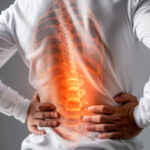What is a disc herniation?
The low back is called the lumbar spine. The spinal column in the front part of the spine is made up of vertebral bodies, which are bones that are separated by the intravertebral disc. An intravertebral disc has a gelatinous gel in the center and a woven capsule on the outside. The capsule is attached to the vertebral body above and below. Injuries to the capsule can occur without symptoms when the capsule develops a tear. The tear can allow some of the gel in the center of the disc to squirt out into the spinal canal, where the nerves are located. This is called a disc herniation. The gel can cause inflammation near the nerve and mechanical compression of the nerve, which in turn causes the nerve to dysfunction, creating pain, numbness and/or weakness.
What are the symptoms of lumbar disc herniation?
Disc herniations typically cause buttock and leg pain called sciatica. Sciatica can be intense is often described as shooting, burning or electrical. Depending on which nerve the herniation is irritating, the pain can run down the back, side, or front of the leg. Often times in the same area of the pain people develop numbness or pins and needle sensations. Some people develop weakness. You can test yourself to see if you have weakness by walking on your tip toes, walking on your heels, and climbing stairs.
How are disc herniations diagnosed?
Once a clinical history of symptoms is reported in the proper location that are typically triggered by sitting, bending, and lifting a physical exam can be conducted. The exam which includes a sitting straight leg raise. In this test a seated person straightens the knee on the painful side and it reproduces the pain. The physical exam also tests reflexes, sensation, and strength. An MRI can take a detailed picture of the low back and confirm the size and location of the disc herniation.
How long will this last?
Sometimes disc herniations can improve on their own over the course of a few weeks, but other times they can last months or longer.
What should I do if I have symptoms of disc herniation?
Initially my recommendation is to avoid prolonged sitting, bending, and lifting. It is usually a good idea to try to keep moving and walking is an excellent low impact exercise. However, if your leg is weak or unstable, walking may be unsafe. Poor exercises may a be a better option. McKenzie extension exercises are also potentially helpful (as described in the book titled “How to Treat Your Own Back” by Robin McKenzie (hyperlink)). If the pain is severe, you have leg weakness, or the symptoms are persisting, you should seek medical care.
What are the medical options?
Often, the first interventional treatment is an epidural steroid injection(Sara- hyper link to my website the section on epidural steroid injections). This is low risk procedure that uses live time Xray to guide an injection of steroid and analgesic medicine next 2 to the injured nerve. Because disc herniations create inflammation, steroids can reduce the inflammation and the symptoms.
What are the surgical options?
There are surgical procedures to remove the disc herniation. The most common one is called a microdiscectomy. In this procedure a small incision is made to allow the surgeon to access the spinal canal and remove the herniated portion of the disc. This surgery is performed with an operating microscope and is frequently performed by orthopedic spine surgeons or neurosurgeons. A less commonly performed procedure is called an endoscopic discectomy. Endoscopic discectomy is performed through a tube, with the goal of removing the herniated portion of the disc. Either surgery can be effective.
Is surgery a last resort?
No. In people who have significant weakness, uncontrolled pain, progressive weakness, or new bowel or bladder dysfunction, surgery may be indicated early. However, most people can be treated successfully without surgery with the techniques described above.
Conclusion:
Lumbar disc herniations are common painful causes of buttock and leg pain that occur in all age groups. Most of the time disc herniations can be managed with time, activity modification, and epidural steroid injections, but surgical intervention can also be helpful. Obtaining professional medical care from a physician like me is a good idea for this condition.

